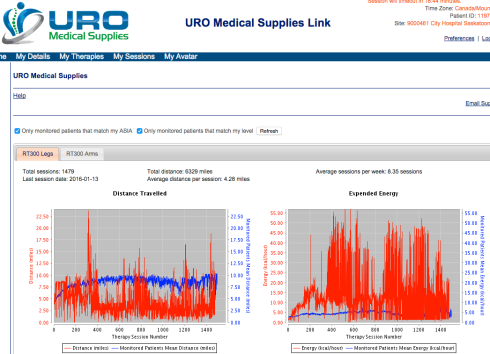Well, if I keep riding an FES bike, I might have to reuse the title of this post a few more times in the future. but still, I did enjoy a great ride on Saturday this week. I have learned that I enjoy my rides more, and often get better results, if I mix it up a bit and don’t simply do the same thing for my entire workout. So in this latest workout, I actually logged four different sessions in succession. First, I did a 20 minute warm-up where I gradually increased both stimulation level and RPM, so my muscles could slowly get warmed up and get used to the stimulation level. Then, I moved on to interval training to work at a high, intense, level. After half an hour of that, I dialled it back and took it easy with some LSD [long slow distance], where I tried to recover my energy with some nice easy pedaling. Finally, one last blast with the interval training, which is where I achieved a new record energy output. More on that below.
Here’s how the warm-up looked: 
My idea for the warm-up, as outlined in a previous post, is to slowly increase both speed (green line) and resistance (magenta line) so that that the stimulation level (light blue line) gradually increases up to a maximum of 100% at or near the end of the 20 minute warm-up. On this day, I hit the 100% level after 18 minutes, and the machine did not substantially reduce the resistance during the last two minutes of the workout. My average power (black line) during the last step of the warm-up was around 20 W, while maximum power (black dots) was around 22 W. Warmed up muscles: Mission accomplished!
After one intense interval session, as I mentioned earlier, I took it easy for a while. Here is what that easy interval looked like:

At first, I had the resistance sent too high, so the machine rapidly increased the stimulation level to 100% and then had to begin reducing the resistance so that my legs could keep up. In the second lap, I got smarter and reduced the resistance. Then the machine slowly increased the resistance level but it never got to 100%. As you can see the average power output was higher in the second lap than in the first lap. Now I was ready for one last intense session. Here’s what that last workout session looked like: 
I did four laps, each one at the maximum resistance of 20.75 Nm and the maximum speed of 55 RPM, followed by 30 seconds of taking it easy. Each successive lap, my average power output increased, with the last one being at 77 W. My overall energy output during this session was over 55 KCalories per hour. That is equivalent to an average of 64 W over the 20 minute period. After my nearly 2-hour workout, I was both happy and tired, and ready for a nice cold beer! Final word: as always, I owe a huge debt of thanks to my fiancée Julie, without whose assistance none of this would be possible.
Tags: exercise, FES











